Page 45 of 219
Seats, restraints43Seats, restraintsHead restraints............................ 43
Front seats ................................... 45
Rear seats ................................... 49
Seat belts ..................................... 53
Airbag system .............................. 57
Child restraints ............................. 62Head restraints
Position9 Warning
Only drive with the head restraint
set to the proper position.
The upper edge of the head restraint
should be at upper head level. If this
is not possible for extremely tall
people, set to highest position, and
set to lowest position for small people.
Adjustment
Head restraints with release button
Press the button, adjust height and
engage.
Page 46 of 219
44Seats, restraints
Head restraints without release
button
Pull the head restraint upwards or
press the catch to release and push the head restraint downwards.
Removing
Press the catches and pull up the
head restraint.
Active head restraints
In the event of a rear-end impact, the active head restraints tilt slightly
forwards. The head is more
effectively supported so the risk of
whiplash injury is reduced.
Active head restraints are identified
by the lettering ACTIVE on the head
restraint guide sleeves.
Notice
Approved accessories may only be
attached to the front passenger seat
head restraint if the seat is not in use.
Page 47 of 219

Seats, restraints45Front seats
Seat position9 Warning
Only drive with the seat correctly
adjusted.
■ Sit with buttocks as far back against
the backrest as possible. Adjust the distance between the seat and the
pedals so that legs are slightly
angled when pressing the pedals.
Slide the front passenger seat as
far back as possible.
■ Sit with shoulders as far back against the backrest as possible.
Set the backrest rake so that it is possible to easily reach the
steering wheel with arms slightly bent. Maintain contact between
shoulders and the backrest when
turning the steering wheel. Do not
angle the backrest too far back. We recommend a maximum rake of
approx. 25°.
■ Adjust the steering wheel 3 78.
■ Set seat height high enough to have a clear field of vision on allsides and of all display instruments.
There should be at least one hand
of clearance between head and the
roof frame. Thighs should rest
lightly on the seat without pressing
into it.
■ Adjust the head restraint 3 43.
■ Adjust the height of the seat belt 3 54.■ Adjust the thigh support so that
there is a space approx. two fingers
wide between the edge of the seat
and the hollow of the knee.
■ Adjust the lumbar support so that it
supports the natural shape of the
spine.
Seat adjustment9 Danger
Do not sit nearer than 25 cm from
the steering wheel, to permit safe
airbag deployment.
9 Warning
Never adjust seats while driving as
they could move uncontrollably.
Page 48 of 219
46Seats, restraints
Seat positioning
Pull handle, slide seat, release
handle.
Seat backrests
Turn handwheel. Do not lean on
backrest when adjusting.
Seat height
Lever pumping motion
up=higherdown=lower
Page 49 of 219
Seats, restraints47
Seat inclination
Pull lever, adjust inclination by
shifting body weight. Release lever
and audibly engage seat in position.
Lumbar support
Turn handwheel. Do not lean on
backrest when adjusting.
Adjustable thigh support
Press the button and slide the thigh
support.
Page 50 of 219
48Seats, restraintsSeat folding
Push the head restraint down.
Slide the seat backwards.
Raise release lever, fold backrest
forward and engage.
To restore the seat to the upright
position, raise release lever and
audibly engage backrest.
Armrest
Push raised armrest backward
against resistance and fold down.
The armrest can be moved to
different positions in stages by lifting
it.
Heating
Adjust heating to the desired setting
by pressing the ß button for the seat
one or more times with the ignition on. The control indicator in the button
indicates the setting.
Prolonged use of the highest setting
for people with sensitive skin is not
recommended.
Seat heating is operational when the
engine is running.
Page 51 of 219
Seats, restraints49Rear seats
Second row seats9 Warning
When the row of seats or the
backrests are being adjusted,
keep hands away from the hinge
area.
Moving seat row
Push the release lever forwards and
slide the row of seats. Release the
lever and audibly engage the seats.
Folding seat row and sliding
forwards
Remove the luggage compartment
cover as required 3 70.
Slide head restraints down 3 43.
Place seat belt buckles in seat
pockets.
Press release lever 1 down and
swivel the seat cushion upwards until
it engages.
Press down release lever 2 on both
sides, bring the backrest into the
upright position and engage.
Pull handle on back of centre
backrest, bring the backrest into the
upright position and engage.
Press release lever 3, slide the bench
to the frontmost position and engage.
To restore, press release lever 3 and
slide the bench to the required
position. Adjust the backrest and use
Page 52 of 219

50Seats, restraints
release lever 1 to swivel the seat
cushion downwards. All positions
must audibly engage.
Adjust backrests of outboardseats
Press the release lever down, select
one of the two inclinations, release
the lever and engage the backrest.
9 Warning
Occupants may only travel on a
seat if its backrest is properly
engaged in the rearward inclined
position.
9 Warning
Only drive the vehicle if the
backrests are securely locked into position. Otherwise there is a risk
of personal injury or damage to the
load or vehicle in the event of
heavy braking or a collision.
Folding down outboard
backrests
Remove the luggage compartment
cover as required 3 70.
Slide head restraints down 3 43.
Place seat belt buckles in seat
cushion pockets.
Press the release lever down, set the
backrest to a vertical position or
angled forward or fold it to the seat
cushion and engage.
To move upright, push release lever
down and latch backrest in required
position.
Folding down middle backrest
Slide the head restraint all the way
down 3 43.
Place seat belt buckles in seat
cushion pockets.